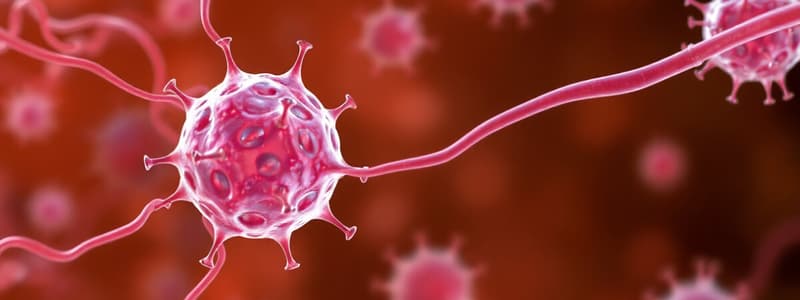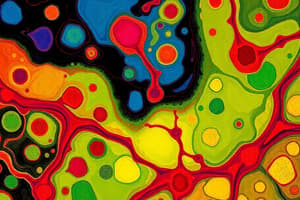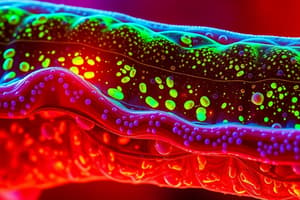Podcast
Questions and Answers
What role do growth factors primarily play in cellular responses?
What role do growth factors primarily play in cellular responses?
- They inhibit cell migration.
- They degrade extracellular matrix components.
- They stimulate cell differentiation.
- They promote cell survival and proliferation. (correct)
Which type of signaling involves a cell responding to substances it releases itself?
Which type of signaling involves a cell responding to substances it releases itself?
- Paracrine signaling
- Autocrine signaling (correct)
- Juxtacrine signaling
- Endocrine signaling
What constitutes a significant portion of any tissue and surrounds cells?
What constitutes a significant portion of any tissue and surrounds cells?
- Intracellular fluid
- Cell membranes
- Nuclear material
- Extracellular matrix (correct)
Which of the following is NOT a function of the extracellular matrix?
Which of the following is NOT a function of the extracellular matrix?
What is the primary component of the basement membrane?
What is the primary component of the basement membrane?
Which type of matrix is found in the spaces between epithelial and connective tissue cells?
Which type of matrix is found in the spaces between epithelial and connective tissue cells?
Which of the following is a characteristic of fibrous structural proteins in the extracellular matrix?
Which of the following is a characteristic of fibrous structural proteins in the extracellular matrix?
What type of signaling involves hormones carried by the bloodstream to distant target cells?
What type of signaling involves hormones carried by the bloodstream to distant target cells?
Which factor is less likely to enhance the wound healing process?
Which factor is less likely to enhance the wound healing process?
What complication is associated with excessive collagen accumulation during wound healing?
What complication is associated with excessive collagen accumulation during wound healing?
Which of the following is NOT classified as a local factor affecting wound healing?
Which of the following is NOT classified as a local factor affecting wound healing?
What condition arises primarily due to increased abdominal pressure post-surgery?
What condition arises primarily due to increased abdominal pressure post-surgery?
Which systemic factor significantly impairs wound healing due to compromised blood supply?
Which systemic factor significantly impairs wound healing due to compromised blood supply?
Which type of excessive formation of tissue arises above the surrounding skin, blocking re-epithelialization?
Which type of excessive formation of tissue arises above the surrounding skin, blocking re-epithelialization?
What term describes a carcinoma that may develop from a scar over a long duration?
What term describes a carcinoma that may develop from a scar over a long duration?
What is a potential consequence of uncontrolled smoking on wound healing?
What is a potential consequence of uncontrolled smoking on wound healing?
What is the primary role of VEGF in the wound healing process?
What is the primary role of VEGF in the wound healing process?
Which component is NOT typically found in granulation tissue?
Which component is NOT typically found in granulation tissue?
What role do metalloproteases play in wound healing?
What role do metalloproteases play in wound healing?
What is a characteristic feature of newly formed blood vessels during the wound healing process?
What is a characteristic feature of newly formed blood vessels during the wound healing process?
What initiates the re-epithelialization process in wound healing?
What initiates the re-epithelialization process in wound healing?
Which growth factor is NOT typically associated with the stimulation of angiogenesis?
Which growth factor is NOT typically associated with the stimulation of angiogenesis?
What happens to the capillaries in mature scar tissue after wound healing is completed?
What happens to the capillaries in mature scar tissue after wound healing is completed?
Which cells are primarily responsible for collagen synthesis during wound healing?
Which cells are primarily responsible for collagen synthesis during wound healing?
What occurs first in the healing process after an injury?
What occurs first in the healing process after an injury?
During the second phase of healing, which cells replace polymorphs after the initial inflammatory response?
During the second phase of healing, which cells replace polymorphs after the initial inflammatory response?
What is the primary function of fibroblasts in the wound healing process?
What is the primary function of fibroblasts in the wound healing process?
Which phase of healing is characterized by the formation of scar tissue?
Which phase of healing is characterized by the formation of scar tissue?
What feature primarily distinguishes healing by second intention from primary healing?
What feature primarily distinguishes healing by second intention from primary healing?
What happens to the scar tissue as it matures in the healing process?
What happens to the scar tissue as it matures in the healing process?
What is the role of myofibroblasts during wound contraction?
What is the role of myofibroblasts during wound contraction?
What defines the presence of granulation tissue?
What defines the presence of granulation tissue?
What role does oxygen play in the formation of mature collagen?
What role does oxygen play in the formation of mature collagen?
Which of the following cytokines is NOT involved in the remodeling phase of wound healing?
Which of the following cytokines is NOT involved in the remodeling phase of wound healing?
What is a primary characteristic of a wound healing by first intention?
What is a primary characteristic of a wound healing by first intention?
How do myofibroblasts contribute during the wound healing process?
How do myofibroblasts contribute during the wound healing process?
What can lead to the formation of hypertrophic scars or keloids?
What can lead to the formation of hypertrophic scars or keloids?
What is one of the key functions of the extracellular matrix in vascular growth?
What is one of the key functions of the extracellular matrix in vascular growth?
What occurs during the transition from granulation tissue to a scar?
What occurs during the transition from granulation tissue to a scar?
Which of the following statements regarding the healing by secondary intention is true?
Which of the following statements regarding the healing by secondary intention is true?
What is the key characteristic that classifies cells as labile?
What is the key characteristic that classifies cells as labile?
Based on the text, why is the ability to proliferate important for tissue repair?
Based on the text, why is the ability to proliferate important for tissue repair?
How does the healing process differ between regeneration and repair?
How does the healing process differ between regeneration and repair?
Which of the following cell types is classified as permanent, based on its proliferative potential?
Which of the following cell types is classified as permanent, based on its proliferative potential?
Which scenario best represents the concept of regeneration in tissue repair?
Which scenario best represents the concept of regeneration in tissue repair?
Which of the following statements accurately describes the role of growth factors in tissue repair?
Which of the following statements accurately describes the role of growth factors in tissue repair?
In the context of tissue repair, what is the primary function of the extracellular matrix?
In the context of tissue repair, what is the primary function of the extracellular matrix?
Which of the following is true about the relationship between regeneration and scar formation in the healing process?
Which of the following is true about the relationship between regeneration and scar formation in the healing process?
Flashcards
Collagen formation
Collagen formation
Requires oxygen for hydroxylation of proline and lysine.
Fibroblasts
Fibroblasts
Cells that produce elastin and organize the extracellular matrix (ECM).
Extracellular matrix (ECM)
Extracellular matrix (ECM)
Support framework for cell migration and growth factor modulation.
TGF-β
TGF-β
Signup and view all the flashcards
Wound remodeling
Wound remodeling
Signup and view all the flashcards
Myofibroblasts
Myofibroblasts
Signup and view all the flashcards
Healing by first intention
Healing by first intention
Signup and view all the flashcards
Hypertrophic scars
Hypertrophic scars
Signup and view all the flashcards
Growth Factors
Growth Factors
Signup and view all the flashcards
Autocrine Signaling
Autocrine Signaling
Signup and view all the flashcards
Paracrine Signaling
Paracrine Signaling
Signup and view all the flashcards
Endocrine Signaling
Endocrine Signaling
Signup and view all the flashcards
Interstitial Matrix
Interstitial Matrix
Signup and view all the flashcards
Basement Membrane
Basement Membrane
Signup and view all the flashcards
Components of ECM
Components of ECM
Signup and view all the flashcards
Wound Contraction
Wound Contraction
Signup and view all the flashcards
Local Factors
Local Factors
Signup and view all the flashcards
Wound Healing Phases
Wound Healing Phases
Signup and view all the flashcards
Acute Inflammatory Response
Acute Inflammatory Response
Signup and view all the flashcards
Systemic Factors
Systemic Factors
Signup and view all the flashcards
Dehiscence
Dehiscence
Signup and view all the flashcards
Polymorphs
Polymorphs
Signup and view all the flashcards
Macrophages
Macrophages
Signup and view all the flashcards
Keloid
Keloid
Signup and view all the flashcards
Epithelial Changes
Epithelial Changes
Signup and view all the flashcards
Osteomyelitis
Osteomyelitis
Signup and view all the flashcards
Granulation Tissue
Granulation Tissue
Signup and view all the flashcards
Nutritional Factors
Nutritional Factors
Signup and view all the flashcards
Healing by Second Intention
Healing by Second Intention
Signup and view all the flashcards
Healing
Healing
Signup and view all the flashcards
Regeneration
Regeneration
Signup and view all the flashcards
Repair
Repair
Signup and view all the flashcards
Labile Cells
Labile Cells
Signup and view all the flashcards
Stable Cells
Stable Cells
Signup and view all the flashcards
Permanent Cells
Permanent Cells
Signup and view all the flashcards
Wound Healing Process
Wound Healing Process
Signup and view all the flashcards
Re-epithelialization
Re-epithelialization
Signup and view all the flashcards
Angiogenesis
Angiogenesis
Signup and view all the flashcards
Collagen deposition
Collagen deposition
Signup and view all the flashcards
VEGF
VEGF
Signup and view all the flashcards
Endothelial cell migration
Endothelial cell migration
Signup and view all the flashcards
Study Notes
Healing and Repair
- Healing is the body's response to injury, aiming to restore normal structure and function.
- Repair involves removing or destroying the harmful agent.
- Regeneration replaces damaged components, returning tissue to a normal state.
- Regeneration occurs through cell proliferation.
- Repair involves connective tissue proliferation leading to fibrosis and scarring.
- Repair can involve both regeneration and repair simultaneously.
Proliferative Potential of Cells
- Cells are classified by their ability to proliferate.
- Labile cells continuously divide throughout life. Examples are stem cells from the epidermis, bone marrow, and the lining of the intestines. These cells regenerate easily after injury.
- Stable cells lose their proliferative ability after adolescence. However, they can divide in response to stimuli. Examples include parenchyma cells from the liver, kidney, pancreas, bone, and cartilage.
- Permanent cells lose their ability to proliferate after birth. Examples include neurons, skeletal muscle, and cardiac muscle.
Growth Factors
- Growth factors are proteins stimulating cell survival, proliferation, migration, and differentiation.
- Growth factors promote cell division and survival.
- They act as signaling molecules, influencing cell entry into the cell cycle and protein synthesis for mitosis.
- Signaling mechanisms include autocrine, paracrine, and endocrine.
Extracellular Matrix (ECM)
- ECM is a complex protein network surrounding cells, forming a significant portion of tissues.
- Tissue repair depends on growth factors and interactions between cells and ECM components.
- ECM components include:
- Fibrous structural proteins (collagen and elastin) providing tensile strength and recoil
- Water-hydrated gels (proteoglycans and hyaluronan) providing hydration and swelling pressure for tissue
- Adhesive glycoproteins (integrins, fibronectin, and laminin connecting ECM elements to each other and cells)
- ECM components form interstitial matrices in spaces between epithelial, endothelial, and smooth muscle cells and in connective tissue.
- The basement membrane is produced by epithelial and mesenchymal cells and is closely associated with cell surfaces. It consists of amorphous non-fibrillar collagen, laminin, heparan sulfate, proteoglycan, and other glycoproteins.
Wound Healing Process
- Wound healing is a dynamic process with four overlapping phases:
- Hemostasis
- Inflammation
- Proliferation/migration
- Remodeling/maturation
- Interruptions or prolongations in the process contribute to delayed or chronic wound healing.
Stages of Wound Healing
- Hemostasis begins immediately after injury, involving vascular constriction, platelet plug formation, blood clot formation, and fibrous tissue growth into the clot to close and permanently seal the hole in the vessel.
- Inflammatory phase: Platelet activation triggers inflammatory cells (neutrophils, monocytes, and fibroblasts) within 1-2 days influenced by PMNs; these cells deposit on a fibrin scaffold; the PMNs are removed through apoptosis. Cytokines (IL-1a, IL-6, and TNF-α) mediate the inflammatory response and prevent infection. Macrophages transform from monocytes and play a role in clearing debris. This phase lasts 4 days.
- Proliferation/migration: The wound rebuilds with new tissue made of collagen and extracellular matrix. This phase involves re-epithelialization and angiogenesis. Endothelial cells migrate on day 2 stimulated by growth factors like VEGF and FGF and angiopoietin.
- Remodeling/maturation: The wound transition from granulation tissue to scar involves changes in extracellular matrix composition. The collagen and ECM are modified and remodeled over several years and are rearranged for increased tensile strength.
Wound Closure Intentions
- Skin wound healing involves epithelial regeneration and connective scar formation.
- Based on nature and size of wound, healing occurs through:
- Primary intention (quick healing in clean, small wounds closed with sutures or adhesives)
- Secondary intention (healing in larger, open wounds or those with extensive tissue loss or contamination)
Factors Affecting Wound Healing
- Local factors (e.g., infection, blood supply, foreign bodies, mechanical stress, tissue type, size, and location of injury) and systemic factors (e.g., age, nutrition, systemic infections, diabetes, smoking, medications).
Complications of Wound Healing
- Deficient scar formation, excessive scar formation (hypertrophic or keloid), and formation of contractures.
- Dehiscence, osteomyelitis, neoplasia are associated as complications of wound healing.
Summary
- Healing is a complex process involving multiple factors and a sequential series of events.
- Healing occurs through primary and secondary intentions and cellular processes like proliferation and remodeling.
Studying That Suits You
Use AI to generate personalized quizzes and flashcards to suit your learning preferences.





